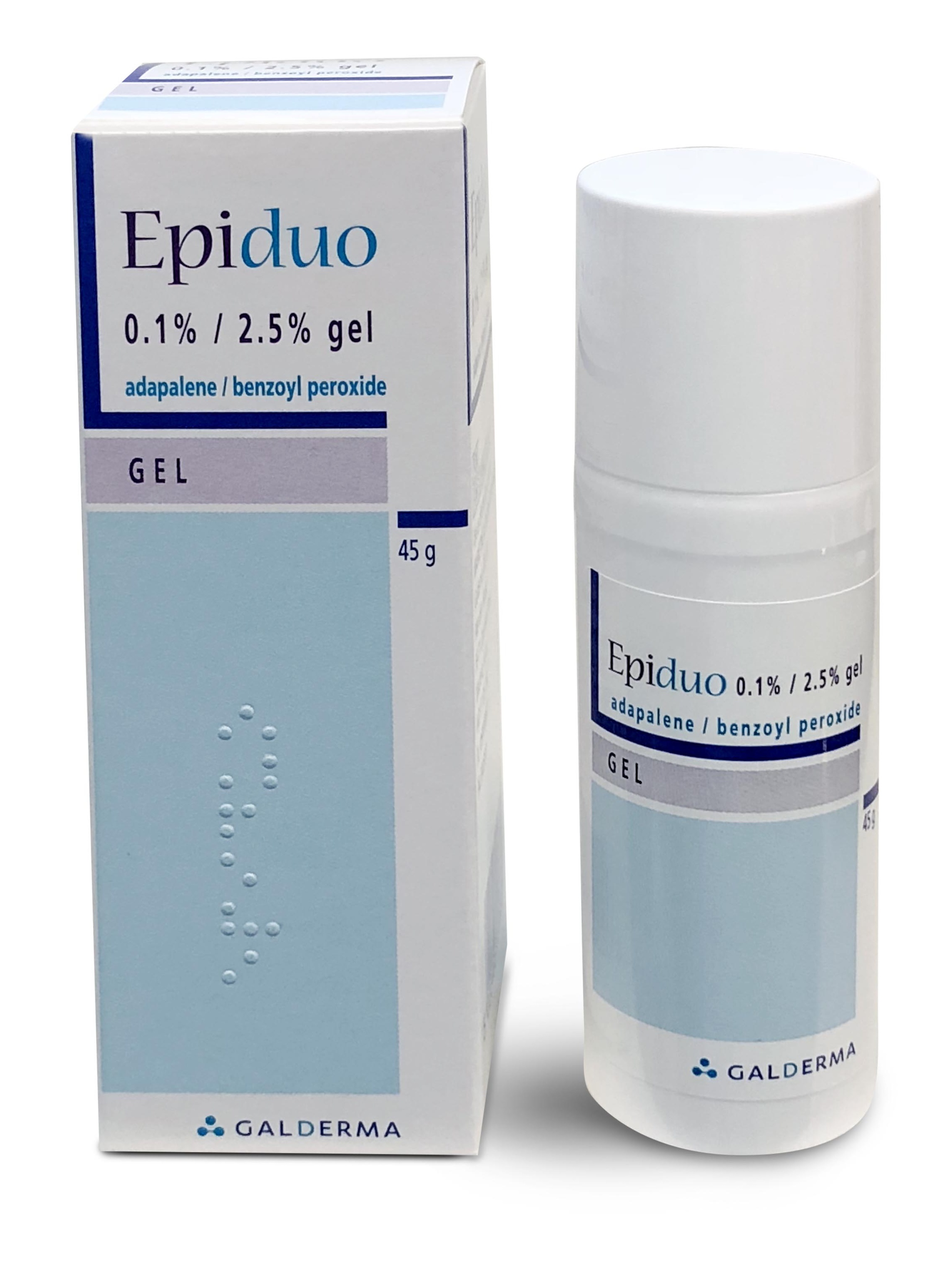
Epiduo 0.1%/2.5% Gel
Highlights
Key Ingredients
Skim through
| Ingredient name | what-it-does | irr., com. | ID-Rating |
|---|---|---|---|
| Adapalene | cell-communicating ingredient, anti-acne | superstar | |
| Benzoyl Peroxide | anti-acne | ||
| Docusate Sodium | surfactant/cleansing, emulsifying | ||
| Disodium Edetate | chelating | ||
| Glycerol | skin-identical ingredient, moisturizer/humectant | 0, 0 | superstar |
| Poloxamer | |||
| Propylene Glycol (E1520) | moisturizer/humectant, solvent | 0, 0 | |
| Simulgel 600 PHA (Copolymer Of Acrylamide And Sodium Acryloyldimethyltaurate, Isohexadecane, Polysorbate 80, Sorbitan Oleate) | |||
| Purified Water | solvent |
Galderma Epiduo 0.1%/2.5% GelIngredients explained

The gold standard topical ingredient in treating acne. There is no miracle cure for acne (we do really wish for one, *sigh*), but Benzoyl Peroxide (BP) is probably the closest thing we have. But, as usual, big effects come with big side effects, so we think BP is best used as a last resort (at least, in the topical treatment field).
The good thing about BP is that it is amazingly effective against inflammatory-type acne. Not so much against blackheads or whiteheads, but against acne that is caused by the evil bacteria called Propionibacterium acnes (and that is most types of acne). Apart from being antibacterial, it is also anti-inflammatory, keratolytic and wound-healing, all of which are properties that make it so darn effective against spots.
Another big pro of BP is that there is no bacterial resistance to it, meaning if it works once it will continue to work. Antibiotics are also a common way to treat acne, but antibiotic-resistant P. acnes are increasing worldwide. BP will probably help you even if antibiotics have stopped working, and the two are also often combined for a more complex acne therapy. Btw, BP plays nice not only with antibiotics but also with retinoids.
The side-effects part? BP works its antibacterial magic by being a powerful oxidizing agent, meaning it is a pro-oxidant. As in the opposite of an antioxidant. BP literally generates evil ROS (reactive oxygen species) in the skin that kills P. acnes but also harms the surrounding skin cells. Ongoing BP-use ages your skin, which is why, we say, use it as a last resort. If you do use BP, please also use a good sunscreen and a good antioxidant serum to apologise to your skin (btw, these things are useful in any case). Use the BP treatment at night and the antioxidant serum in the morning so that they do not cancel each other out.
Another side effect of BP is that it can be very skin drying. BP is an example where more is not better. In fact, it is equally effective at concentrations of 2.5, 5.0 and 10%, but the higher the concentration the more irritating and drying side effects occur. So using BP at 2.5% percent is the ideal amount. Another side effect which is good to know is that BP can bleach bedsheets and clothes. Be careful with your expensive satin bedsheets.
Overall, Benzoyl Peroxide is a uniquely effective topical acne treatment, but it comes at a price. Use it as a last resort and for good measure (and with plenty of moisturizers, sunscreen, and antioxidant serum).

Super common little helper ingredient that helps products to remain nice and stable for a longer time. It does so by neutralizing the metal ions in the formula (that usually get into there from water) that would otherwise cause some not so nice changes.
It is typically used in tiny amounts, around 0.1% or less.
- A natural moisturizer that’s also in our skin
- A super common, safe, effective and cheap molecule used for more than 50 years
- Not only a simple moisturizer but knows much more: keeps the skin lipids between our skin cells in a healthy (liquid crystal) state, protects against irritation, helps to restore barrier
- Effective from as low as 3% with even more benefits for dry skin at higher concentrations up to 20-40%
- High-glycerin moisturizers are awesome for treating severely dry skin
This ingredient name is not according to the INCI-standard. :( What, why?!
- It's a helper ingredient that improves the freeze-thaw stability of products
- It's also a solvent, humectant and to some extent a penetration enhancer
- It has a bad reputation among natural cosmetics advocates but cosmetic scientists and toxicology experts do not agree (read more in the geeky details section)
This ingredient name is not according to the INCI-standard. :( What, why?!
Good old water, aka H2O. The most common skincare ingredient of all. You can usually find it right in the very first spot of the ingredient list, meaning it’s the biggest thing out of all the stuff that makes up the product.
It’s mainly a solvent for ingredients that do not like to dissolve in oils but rather in water.
Once inside the skin, it hydrates, but not from the outside - putting pure water on the skin (hello long baths!) is drying.
One more thing: the water used in cosmetics is purified and deionized (it means that almost all of the mineral ions inside it is removed). Like this, the products can stay more stable over time.
You may also want to take a look at...
| what‑it‑does | cell-communicating ingredient | anti-acne |
| what‑it‑does | anti-acne |
| what‑it‑does | surfactant/cleansing | emulsifying |
| what‑it‑does | chelating |
| what‑it‑does | skin-identical ingredient | moisturizer/humectant |
| irritancy, com. | 0, 0 |
| what‑it‑does | moisturizer/humectant | solvent |
| irritancy, com. | 0, 0 |
| what‑it‑does | solvent |





